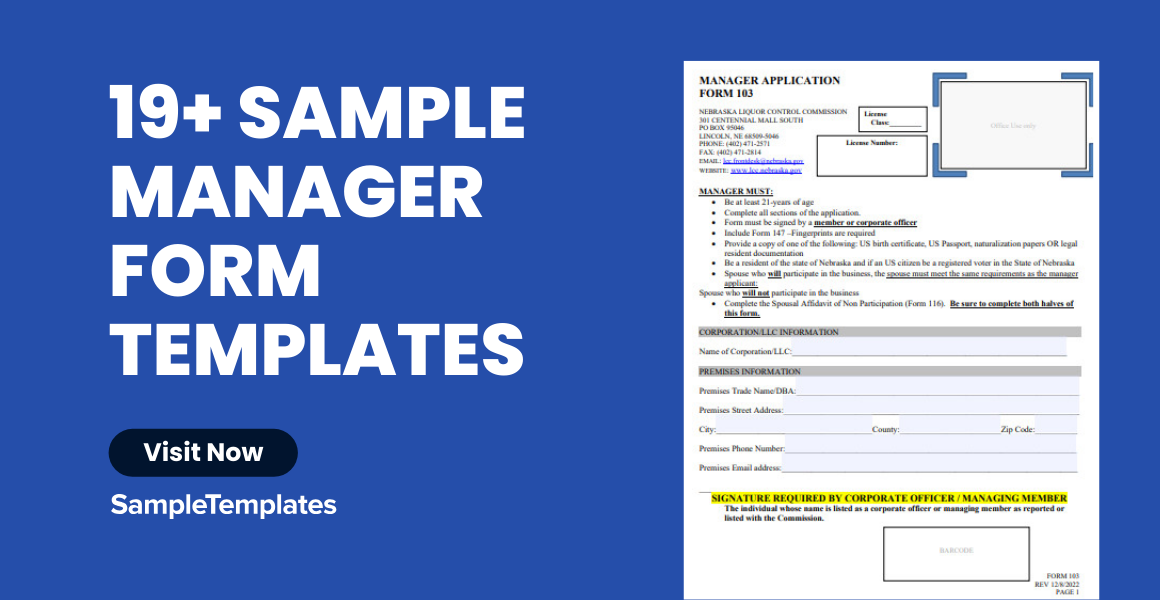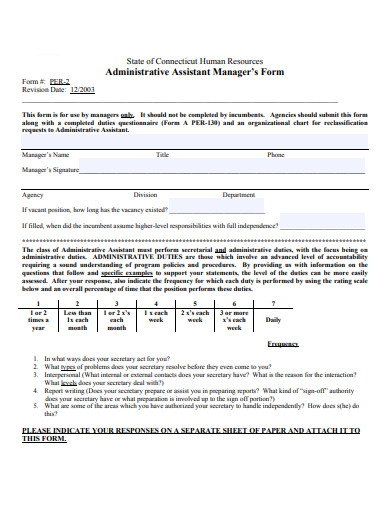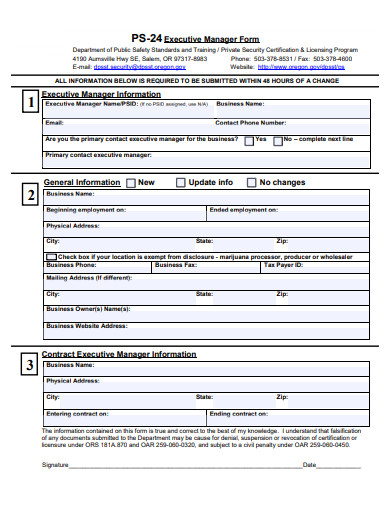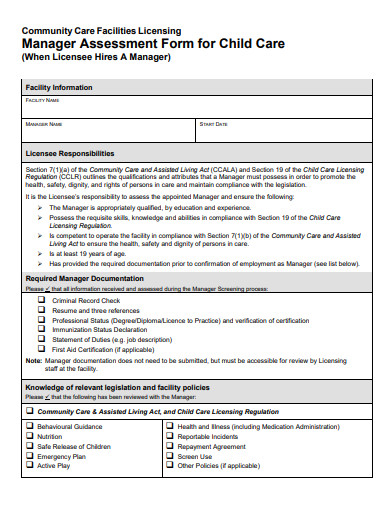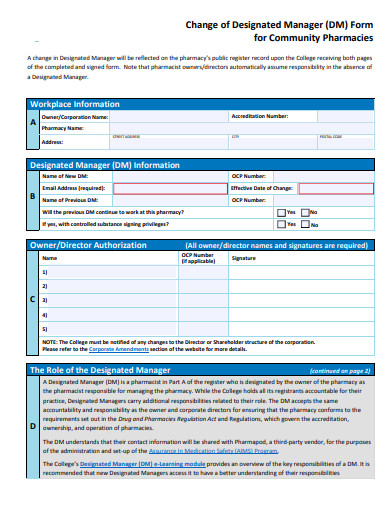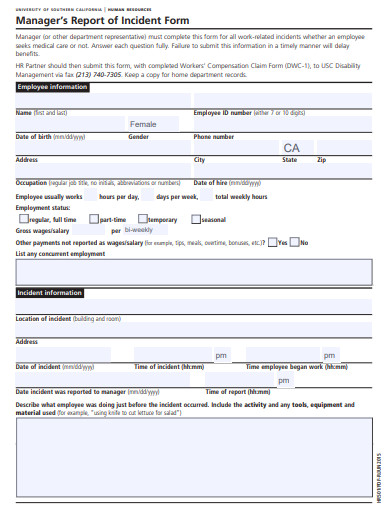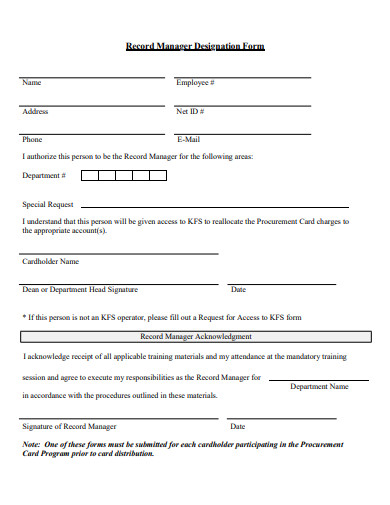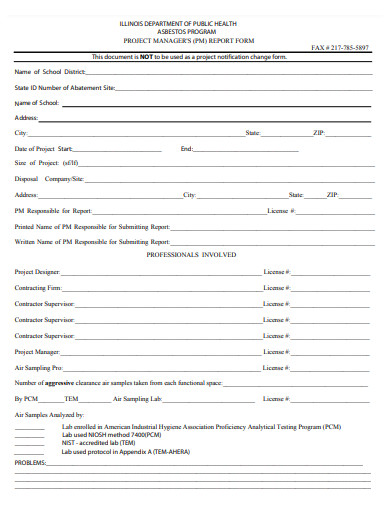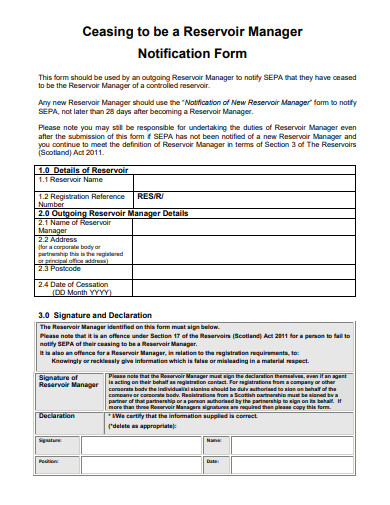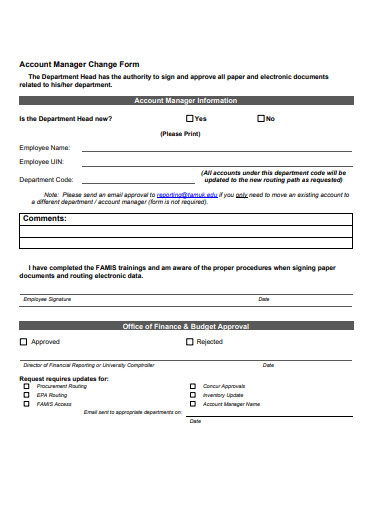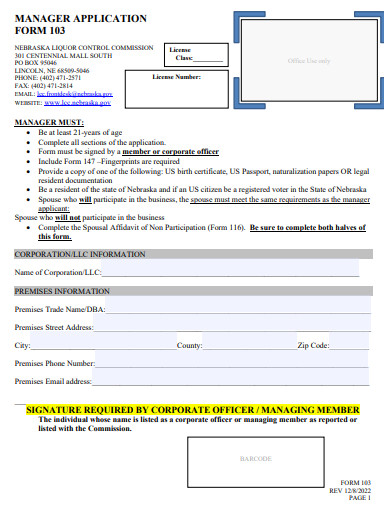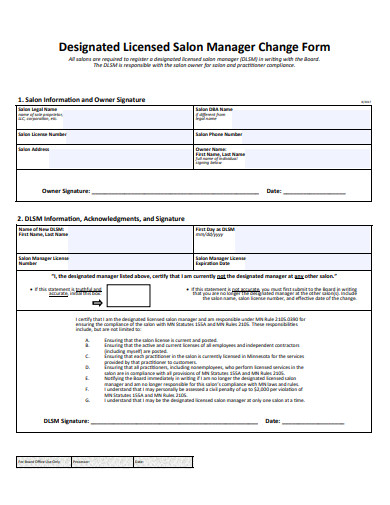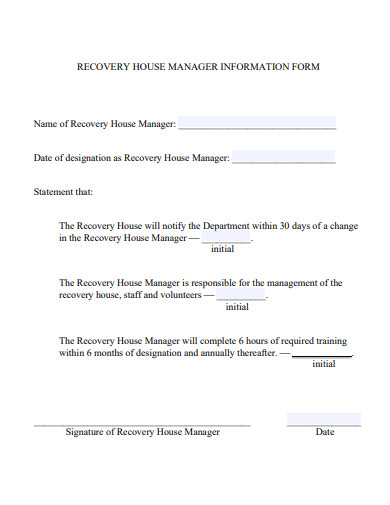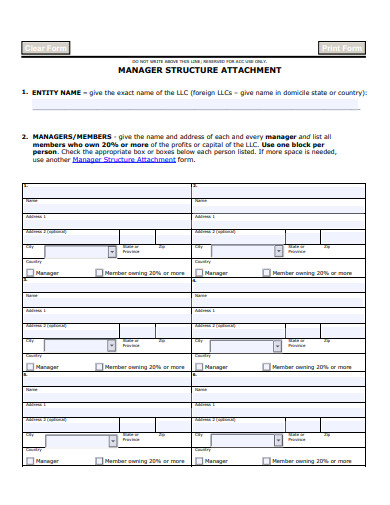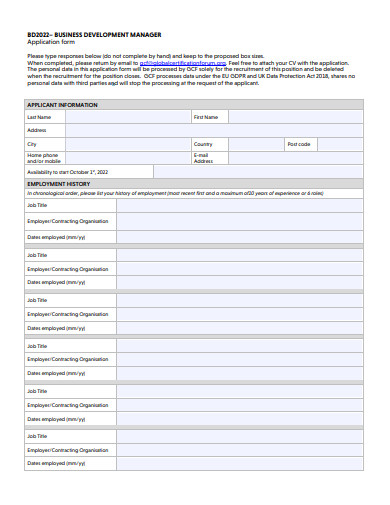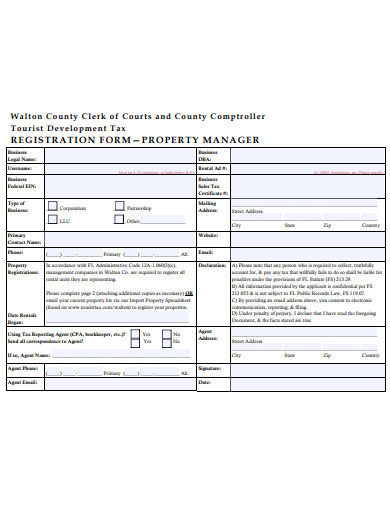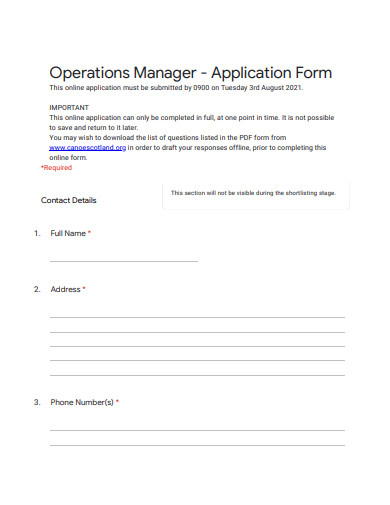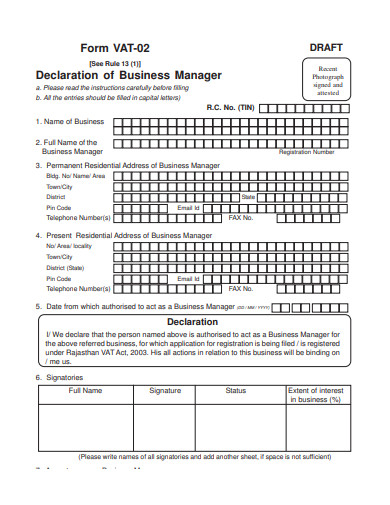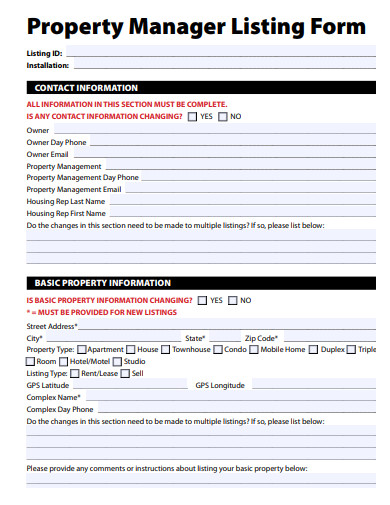Unlock the next phase of your leadership journey with our comprehensive Manager Form. Specifically designed for forward-thinking professionals, this form bridges the gap between managerial theory and hands-on application form. Whether you’re a budding supervisor or a seasoned director, leverage this resource to refine your strategies, foster team growth, and ascend the corporate ladder with confidence. Dive in and let the transformative power of strategic management guide your success.
19+ Manager Form Samples
1. Administrative Assistant Managers Form Template
2. Executive Manager Form Template
3. Manager Assessment Form For Child Care Template
4. Change of Designated Manager Form Template
5. Managers Report of Incident Form Template
6. Record Manager Designation Form Template
7. Project Managers Report Form Template
8. Reservoir Manager Notification Form Template
9. Account Manager Change Form Template
What is a Manager Form?
At its core, a manager form is a tool used by organizations to evaluate, guide, or provide feedback form to those in managerial positions. It can serve a myriad of purposes, from assessing managerial performance and competencies to helping individuals identify areas of improvement in their leadership roles.
The Importance of Managerial Feedback
Managerial roles come with great responsibility. The decisions made at this level influence team morale, productivity, and the overall success of a project or even the entire organization. A manager form acts as a feedback mechanism, providing insights into how effectively a person is performing in their role. The feedback derived from these forms can be invaluable for continuous professional development.
Components of a Typical Manager Form
While the specific elements can vary depending on the organization and its objectives, most manager forms include the following sections:
- Self-assessment: Allows managers to reflect on their performance, understanding their strengths and areas for improvement.
Team feedback: Collected anonymously from team members, this section provides insights into how the manager’s leadership is perceived by those they lead. - Goal setting: Helps managers outline their future objectives and the strategies they intend to use to achieve them.
- Skills assessment: Evaluates the manager’s proficiency in various competencies like communication, delegation, strategic planning, and more.
Versatility in Application
Manager forms are not one-size-fits-all. They can be adapted to different sectors, industries, and levels of management. Whether for middle management in a tech startup or senior leadership in a multinational corporation, the structure and questions can be tailored to fit the unique requirements of the situation.
How to Create a Manager Form?
Before diving into the creation process, it’s crucial to clarify the primary aim of the form. Is it for annual reviews? Monthly check-ins? Ad hoc feedback? Pinpointing the objective will guide the content and structure of the form.
Choosing the Right Format
Manager forms can be digital, paper-based, or even integrated into performance management software. Depending on the organization’s infrastructure and preferences, you might opt for online surveys, downloadable PDFs, or traditional printed forms.
Incorporating Essential Sections
As mentioned earlier, typical manager forms include self-assessments, team feedback, goal setting, and skills assessment. However, depending on the purpose, you might also want to include:
Leadership scenarios: Present hypothetical situations and gauge how the manager would respond, providing insights into their decision-making processes.
Training needs assessment: Identify any gaps in the manager’s skills that can be addressed through further training or resources.
Sourcing Feedback Collaboratively
Engage other team leaders, HR personnel, and even employees to gather insights on what they believe should be included in the form. This collaborative approach ensures that the form is comprehensive and resonates with the broader team.
Ensuring Anonymity
If the form collects feedback from team members, it’s essential to guarantee anonymity. This will encourage honest feedback without fear of repercussions. Consider using platforms that allow anonymous submissions or setting up a process where responses are collated without identifiers.
Piloting and Refinement
Before rolling out the manager form organization-wide, test it with a smaller group. Gather feedback on the form’s usability, clarity, and relevance. Use this feedback to refine and improve the form, ensuring it serves its intended purpose effectively.
Providing Guidelines
To get the most accurate and useful feedback, provide guidelines or training on how to fill out the form. Whether it’s a guide on how to self-assess or how to provide constructive feedback, a little direction can go a long way in enhancing the quality of the responses.
Regular Updates
The business world is dynamic, with changing norms, technologies, and best practices. As such, regularly review and update the manager form to ensure it remains relevant and effective. This might involve adding new sections, tweaking questions, or even changing the format altogether based on evolving needs.
10. Request to Change Fund Manager Form Template
11. Manager Application Form Template
12. Designated Licensed Salon Manager Change Form Template
13. Recovery House Manager Information Form Template
14. Manager Structure Attachment Form Template
15. Safety Manager Experience Verification Form Template
16. Business Development Manager Application Form Template
17. Property Manager Registration Form Template
18. Operations Manager Application Form Template
19. Declaration of Business Manager Form Template
20. Property Manager Listing Form Template
How does Forms Management Impact the Product?
Forms, often perceived as simple data collection tools, play a critical role in shaping a user’s interaction with a product. Whether it’s signing up for an account, entering payment details, or providing feedback, the form is a direct touchpoint between the user and the product.
Enhancing User Experience
Well-designed forms, underpinned by robust forms management, can significantly elevate the user experience. When forms are intuitive, concise, and easy to navigate, they reduce friction and encourage users to complete desired actions, be it a purchase, sign-up, or survey participation.
Data Accuracy and Integrity
Through forms management, products can ensure that the data collected is accurate and consistent. Implementing validation checks, for instance, ensures that users input data in the correct format, which is crucial for functionalities like search, analysis, and reporting.
Driving Business Decisions
The data collected through forms is often used to guide business decisions. From understanding user preferences to identifying market gaps, the insights derived from form data are invaluable. Effective forms management ensures that this data is captured systematically, enabling businesses to make informed decisions.
Ensuring Compliance and Security
With increasing concerns about data privacy and protection, forms management plays a pivotal role in ensuring compliance with regulations. By managing how data is collected, stored, and processed, products can guarantee that they adhere to legal and ethical standards, thereby building trust with users.
What are the Form Management Procedures?
The first step in form management is designing the form. This involves deciding the layout, fields, and structure based on the data that needs to be collected. Factors like form length, field types (e.g., text, dropdown, radio buttons), and the sequence of questions all come into play.
Setting Validation Rules
Once the form’s design is in place, the next step is to establish validation rules. These rules determine the format and type of data that can be entered into each field. For example, a field meant for phone numbers might only accept numeric inputs and might have a specified length.
Data Storage and Retrieval
Establishing a procedure for how form data will be stored is crucial. This involves deciding on databases, ensuring data encryption, and setting up backup procedures. Additionally, there should be a systematic way to retrieve this data for analysis or other business needs.
User Interface Considerations
The user interface (UI) of the form greatly impacts user experience. Form management procedures should outline guidelines for form aesthetics, including font sizes, colors, field spacing, and error message displays, to ensure a consistent and user-friendly interface.
Form Testing and Iteration
Before a form goes live, it should be tested rigorously. This ensures that all validation rules work, the UI is intuitive, and the data storage mechanism is foolproof. Based on feedback and test results, the form might undergo iterations to improve its efficiency.
Data Security and Compliance
Given the sensitive nature of data that forms might collect, establishing security protocols is a must. This includes measures like SSL encryption, secure data transmission, and restricted access. Additionally, there should be procedures in place to ensure that data collection and storage are compliant with relevant regulations.
Form Update and Archival
As business needs evolve, forms might need updates. The form management procedure should outline how updates are made, ensuring that data from older versions remains accessible. Moreover, there should be a system for archiving old forms and their data, ensuring historical data is preserved.
Feedback Mechanism
Lastly, a mechanism to gather feedback on the form from users can be instrumental. This feedback can provide insights into any issues or areas of improvement, ensuring the form remains efficient and user-centric.
Related Posts
Sample Sworn Affidavit Forms
Vehicle Inspection Forms Samples & Templates
Sample Employee Advance Forms
Sample Child Travel Consent Forms
Sample Testimonial Request Forms
Sample Employee Details Forms
Sample Divorce Forms
Sample Attestation Forms
Employee Performance Appraisal Form Templates
FREE 9+ Sample Presentation Evaluation Forms in MS Word
FREE 10+ School Admission Form Samples & Templates in MS Word | PDF
FREE 30+ Patient Consent Form Samples in PDF | MS Word
FREE 10+ Sample Sign Off Form Templates in PDF | MS Word
FREE 11+ Sample Medical Consultation Forms in PDF | MS Word
FREE 8+ Sample Donation Forms in PDF | MS Word
